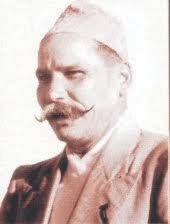
The Nepali Congress is the oldest democratic socialist political party in Nepal and the largest party in the country. The party has 870,106 members as of the party's 14th general convention in December 2021 making them the largest party by membership in Nepal. Currently the party has started online membership since the emergence of youth leaders in vital post to bring youths into the party.

Nepal Ratna Girija Prasad Koirala, affectionately known as Girija Babu, was a Nepalese politician. He headed the Nepali Congress and served as the Prime Minister of Nepal on four occasions, including from 1991 to 1994, 1998 to 1999, 2000 to 2001, and 2006 to 2008. He was the Acting Head of State of Nepal between January 2007 and July 2008 as the country transitioned from a monarchy to a republic.

Krishna Prasad Bhattarai also known as Kishunji was a Nepalese political leader. He was one of the main leaders involved in transitioning Nepal from an absolute monarchy to a democratic multi-party system.
General elections were held in Nepal on 12 May 1991, to elect 205 members to the House of Representatives. The elections were the first multi-party elections since 1959. The 1990 Nepalese revolution successfully made King Birendra to restore a multi-party system after King Mahendra had established the Rastriya Panchayat when he dissolved the parliament in December 1960.

Sushil Prasad Koirala was a Nepalese politician and the Prime Minister of Nepal from 11 February 2014 to 10 October 2015. He was also President of the Nepali Congress from 2010 to 2016, having earlier served under various capacities in the party.

Dhyan Govinda Ranjit a.k.a. Dhyan Govinda Ranjitkar is a Nepalese politician and a leader of Nepali Congress. He is a member of Nepalese constituent assembly/Nepalese Parliament. Ranjit has twice been elected to the Nepalese Constituent Assembly from Kathmandu constituency on two consecutive elections. He is an elected member of Nepali Congress parliamentary party working committee representing Province-3. He was a representative of Nepali Congress in work editing committee. He is the Past President of Kathmandu District Committee of Nepali Congress.

Subarna Shamsher Rana was a leading figure in the movement to overthrow the ruling Rana oligarchy and to establish democracy in Nepal. He was one of the three leaders of the Nepali Congress in the late 1940s, opposing his relatives, the Rana family, who held power in Nepal at the time.
Shailaja Acharya was a Nepali revolutionary, politician and diplomat. She served as The Prime Minister of Nepal for three months in 1998, She also was the first Nepali woman to be elected as the Deputy Prime Minister of Nepal

Ganesh Prasad Rijal was a Nepali politician. He took part in the 1951 democratic revolution of Nepal and later in 1959, elected as a member of parliament from Ilam district. On 15 December 1960, King Mahendra suspended the constitution, dissolved the elected parliament, dismissed the cabinet, imposed direct rule and imprisoned the then prime minister Bishweshwar Prasad Koirala and his closest government colleagues. After King Mahendra's coup, Rijal was exiled to India along with other leaders and workers of Nepali Congress party. During his exile, he resided in Kalimpong and Naxalbari in Indian state of West Bengal. He returned homeland in 1975 following government granting amnesty, and continued his political career, residing in Damak and Kathmandu simultaneously.
Amik Sherchan is a Nepalese politician and current Governor of Lumbini Province of Nepal. He is former chairman of Janamorcha Nepal. He served as the Deputy Prime Minister & Health and Population Minister of Nepal in the interim government under Girija Prasad Koirala cabinet. He also served as the 2nd Governor of Gandaki Province of Nepal. He is active as a politician and prominent leader since 1967. He was elected as a member of the Pratinidhi Sabha and Member of 1st Constituent Assembly from Chitwan.

Matrika Prasad Koirala formed the first government of Nepal by a commoner after he was appointed as the prime minister by King Tribhuvan. The government was formed after the previous government under Mohan SJB Rana fell after Nepali Congress ministers resigned. King Tribhuvan made a royal proclamation on 16 November 1951 and invited Matrika Prasad Koirala from the Nepali Congress to form the government.

Matrika Prasad Koirala formed his second government in 1953 after his appointment by King Tribhuvan. The cabinet was expanded in February 1954 to include Nepal National Congress, Nepal Praja Parishad and Nepali Jan Congress.

Tanka Prasad Acharya formed a government on 27 January 1956 after being appointed as prime minister by King Mahendra. The cabinet was expanded in February 1957 to add more deputy ministers.

Kunwar Inderjit Singh formed a government on 26 July 1957 after being appointed by King Mahendra. He replaced Tanka Prasad Acharya who had resigned on the same day.
Krishna Prasad Sitaula is a Nepali politician, belonging to the Nepali Congress. He who is the leader of Nepali Congress parliamentary party in upper house, Rastriya Sabha. Sitaula is known for playing an important role during the comprehensive peace accord.













